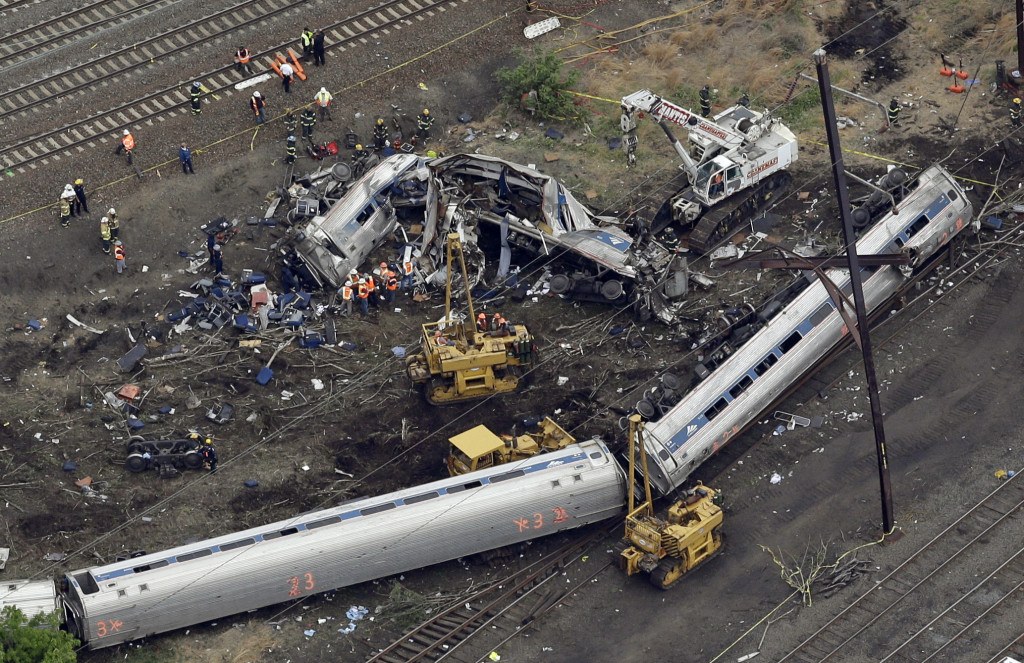There are many questions surrounding Tuesday’s Amtrak crash. The amount of money victims could receive for injuries isn’t one of them as federal law caps total rail-accident damages at $200 million.
Congress established the limit in 1997 on all rail accidents, not just Amtrak, as part of a compromise to bail out the ailing railroad. It’s an arbitrary cap imposed regardless of the number of victims or how horrific the accident, said Joanne Doroshow, executive director of New York Law School’s Center for Justice & Democracy.
“In a mass casualty situation like this, clearly it is way too low,” Doroshow said of the Philadelphia crash which killed eight people and injured about 200. “Medical injuries alone could exceed $200 million.”
As federal investigators turn their attention to the actions of a train engineer in the May 12 derailment, plaintiff lawyers are gearing up for what is likely to be a protracted legal fight for victims, about a dozen of whom remain in critical condition at Philadelphia-area hospitals. The 1997 law limits damages against all defendants for all claims arising from a single accident, which means a judge will ultimately need to decide how the money gets divvied up among victims.
Employee Lawsuit
An Amtrak employee who was on the train filed what may be the first lawsuit in Philadelphia federal court on Thursday. Bruce Phillips suffered a traumatic brain injury and multiple contusions and lacerations in the accident and seeks more than $150,000 in damages, according to a copy of the complaint posted on the website of the city’s NBC affiliate. The filing couldn’t be confirmed immediately in court records.
Plaintiff lawyers will probably challenge the constitutionality of the cap, said Tom Kline, an attorney with Kline & Specter in Philadelphia who’s already speaking to potential clients. Amtrak could aid the process by admitting it was liable in the accident and speeding up the assessment of damages or the railroad could set up a separate victims’ fund like what was done in the BP oil spill, Kline said.
“It’s obvious that with the loss of life and horrific injuries, that $200 million is not going to compensate these victims,” Kline said. “It may end up at the end of the day that there is not a limitation if punitive damages is a separate claim and if Congress sees fit to pass some extension legislation given the enormity of the impact and the tragedy.”
Busiest Corridor
Amtrak’s New York-bound Northeast Regional Train 188, which originated in Washington, went off the tracks about 9:30 p.m., closing part of the busiest passenger-rail corridor in the U.S. The train, carrying 238 passengers and five crew members, was traveling 106 miles per hour when it derailed along a curved section of track in Philadelphia’s Frankford neighborhood.
Train engineer Brandon Bostian, 32, has no recollection of the accident. Bostian, who was knocked out by a concussion, has yet to speak to National Transportation Safety Board personnel investigating the incident.
Bostian, of Forest Hills, New York, applied full brakes, slowing the train to 102 mph on the 50 mph curve before it derailed, Robert Sumwalt, an NTSB member said on Wednesday. The NTSB said it determined the speed based on preliminary data.
That the train was traveling in excess of 100 miles an hour would put Amtrak on the hook for the driver’s negligence at the very least, said Sean Quinn, an attorney with Philadelphia-based Quinn Law Group who has represented train accident victims.
“Amtrak is the low hanging fruit,” Quinn said. “The question we don’t know yet is whether there was any mechanical failure.”
Amtrak could choose to pay more to victims if compensation for injuries does exceed $200 million, although that scenario is unlikely, Doroshow said.
Bronx Derailment
Excess speed was also a factor in the 2013 derailment of a Metro-North train in the Bronx that killed four people. The train’s engineer fell asleep before hitting a curve at 82 miles an hour (132 kilometers per hour) despite a 30 mph limit, according to a report by the National Transportation Safety Board. The employee had a sleep disorder compounded by a change in his work schedule, according to the Oct. 28 report.
Prosecutors in the Bronx have decided not to charge the engineer in that crash, Terry Raskyn, a spokeswoman for the Bronx County district attorney, said Thursday.
Victims of a September 2008 Metrolink crash in Chatsworth, California, called on the railroad and another company to fund a $64 million gap in damages.
The railroad refused, citing the federal cap. The accident, the result of a collision between two trains on a single track, killed 24 people and injured more than 100. After hearing three months of testimony in 2011, state court judge Peter D. Lichtman likened his decision of determining victim payouts to “Sophie’s Choice.”
Lichtman wrote he was forced to conduct “judicial triage” categorizing injuries among more than 120 victims and making awards on the basis of what the future would hold for many of them and their families.
–With assistance from Edvard Pettersson in Federal court in Los Angeles, Pamela Maclean in San Francisco and Michelle Kaske and Henry Goldman in New York.
Related:
- Amtrak Train Was Going at Double Speed Limit
- Metro-North Train Derails Near Rivers in Bronx, Killing Four
- Damages Limit at Issue in Los Angeles Train Crash
Was this article valuable?
Here are more articles you may enjoy.


 Munich Re: Insured Losses From Wildfires, Storms and Floods Hit Record High
Munich Re: Insured Losses From Wildfires, Storms and Floods Hit Record High  Tesla, EEOC Plan Talks to Settle Factory Racism Suit
Tesla, EEOC Plan Talks to Settle Factory Racism Suit  What The Return of California’s ‘Death Discount’ Means for Litigation
What The Return of California’s ‘Death Discount’ Means for Litigation  OpenAI And Microsoft Sued Over Murder-Suicide Blamed on ChatGPT
OpenAI And Microsoft Sued Over Murder-Suicide Blamed on ChatGPT 